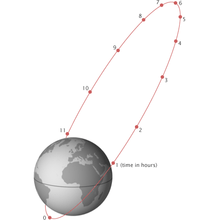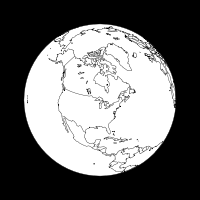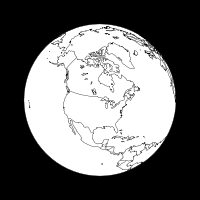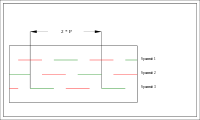Molniya orbit


A Molniya orbit (Russian: Молния; IPA: [ˈmolnʲɪjə], "Lightning") is a type of highly elliptical orbit with an inclination of 63.4 degrees, an argument of perigee of −90 degrees and an orbital period of one half of a sidereal day. Molniya orbits are named after a series of Soviet/Russian Molniya communications satellites which have been using this type of orbit since the mid-1960s.
A satellite in a highly eccentric orbit spends most of its time in the neighborhood of apogee which for a Molniya orbit is over the Northern Hemisphere, the sub-satellite point at apogee having a latitude of 63.4 degrees north. As the apogee altitude is as high as 40,000 km, it will therefore, for a considerable period around apogee, have an excellent visibility from the Northern Hemisphere, from the Russian Federation but also from northern Europe, Greenland and Canada.
To get a continuous high elevation coverage of the Northern Hemisphere, at least three Molniya spacecraft are needed.
The reason that the inclination should have the value 63.4° is that then the argument of perigee is not perturbed by the J2 term of the gravitational field of the Earth but stays at −90°.
Diagrams
 Figure 2: Illumination zones (at least 10° elevation) from a Molniya orbit. At apogee, the green illumination zone applies, three hours before or after apogee, the red zone applies, four hours before or after apogee, the blue zone applies. The plane of the figure is the longitudinal plane of apogee rotating with the Earth. In the eight-hour period centered at the apogee passage, the longitudinal plane is almost fixed, the longitude of the satellite varies by only ±2.7°. The views of the Earth from these three points are displayed in figures 3–8
Figure 2: Illumination zones (at least 10° elevation) from a Molniya orbit. At apogee, the green illumination zone applies, three hours before or after apogee, the red zone applies, four hours before or after apogee, the blue zone applies. The plane of the figure is the longitudinal plane of apogee rotating with the Earth. In the eight-hour period centered at the apogee passage, the longitudinal plane is almost fixed, the longitude of the satellite varies by only ±2.7°. The views of the Earth from these three points are displayed in figures 3–8 Figure 3: View of the Earth four hours before apogee from a Molniya orbit under the assumption that the longitude of the apogee is 90° E. The spacecraft is at an altitude of 24,043 km over the point 92.65° E 47.04° N.
Figure 3: View of the Earth four hours before apogee from a Molniya orbit under the assumption that the longitude of the apogee is 90° E. The spacecraft is at an altitude of 24,043 km over the point 92.65° E 47.04° N. Figure 4: View of the Earth from the apogee of a Molniya orbit under the assumption that the longitude of the apogee is 90° E. The spacecraft is at an altitude of 39,867 km over the point 90° E 63.43° N.
Figure 4: View of the Earth from the apogee of a Molniya orbit under the assumption that the longitude of the apogee is 90° E. The spacecraft is at an altitude of 39,867 km over the point 90° E 63.43° N. Figure 5: View of the Earth four hours after apogee from a Molniya orbit under the assumption that the longitude of the apogee is 90° E. The spacecraft is at an altitude of 24,043 km over the point 87.35° E 47.04° N
Figure 5: View of the Earth four hours after apogee from a Molniya orbit under the assumption that the longitude of the apogee is 90° E. The spacecraft is at an altitude of 24,043 km over the point 87.35° E 47.04° N Figure 6: View of the Earth four hours before apogee from a Molniya orbit under the assumption that the longitude of the apogee is 90° W. The spacecraft is at an altitude of 24,043 km over the point 87.35° W 47.04° N.
Figure 6: View of the Earth four hours before apogee from a Molniya orbit under the assumption that the longitude of the apogee is 90° W. The spacecraft is at an altitude of 24,043 km over the point 87.35° W 47.04° N. Figure 7: View of the Earth from the apogee of a Molniya orbit under the assumption that the longitude of the apogee is 90° W. The spacecraft is at an altitude of 39,867 km over the point 90° W 63.43° N.
Figure 7: View of the Earth from the apogee of a Molniya orbit under the assumption that the longitude of the apogee is 90° W. The spacecraft is at an altitude of 39,867 km over the point 90° W 63.43° N. Figure 8: View of the Earth 4 hours after apogee from a Molniya orbit under the assumption that the longitude of the apogee is 90° W. The spacecraft is at an altitude of 24,043 km over the point 92.65° W 47.04° N
Figure 8: View of the Earth 4 hours after apogee from a Molniya orbit under the assumption that the longitude of the apogee is 90° W. The spacecraft is at an altitude of 24,043 km over the point 92.65° W 47.04° N Figure 9: A constellation of three Molniya spacecraft providing service for the Northern hemisphere. P is the orbital period. A green line corresponds to service for Asia and Europe with the visibility of figures 3–5. A red line corresponds to service for Northern America with the visibility of figures 6–8
Figure 9: A constellation of three Molniya spacecraft providing service for the Northern hemisphere. P is the orbital period. A green line corresponds to service for Asia and Europe with the visibility of figures 3–5. A red line corresponds to service for Northern America with the visibility of figures 6–8
Properties
Much of the area of the former Soviet Union, and Russia in particular, is located at high latitudes. To broadcast to these latitudes from a geostationary orbit (above the Earth's equator) would require considerable power due to the low elevation angles. A satellite in a Molniya orbit is better suited to communications in these regions because it looks directly down on them. In fact, in the period from apogee −3 hours to apogee +3 hours, the sub-satellite point of the spacecraft is north of latitude 55.5° N and the elevation of the spacecraft is over 10° from all points north of latitude 54.1° N and over 5° from all points north of latitude 49.2° N.
An additional advantage is that considerably less launch energy is needed to place a spacecraft into a Molniya orbit than into a geostationary orbit. Disadvantages are that, as opposed to a spacecraft in a geostationary orbit, the ground station needs a steerable antenna to track the spacecraft and that the spacecraft will pass the Van Allen radiation belt four times per day.
It is necessary to have at least three spacecraft if permanent high elevation coverage is needed for a large area like the whole of Russia where some parts are as far south as 45° N. If three spacecraft are used, each spacecraft is active for periods of eight hours per orbit centered at apogee as illustrated in figure 9. The Earth completes half a rotation in 12 hours, so the apogees of successive Molniya orbits will alternate between one half of the northern hemisphere and the other half. For example if the apogee longitudes are 90° E and 90° W, the apogees will alternately serve Europe and Asia (see figures 3 to 5) and next Northern America (see figures 6 to 8). The orbits of the three spacecraft should then have the same apogee longitudes (for example 90° W and 90° E), but pass the apogee with eight hours shift; i.e. the right ascensions of the ascending nodes should be separated with 120°. When one spacecraft has reached the point corresponding to figure 5 (or figure 8) four hours after apogee passage, the next spacecraft has four hours left to reach apogee and having a right ascension of ascending node 120° larger than the previous spacecraft. Said next spacecraft has the visibility displayed in figure 3 (or figure 6) and the switch-over can take place. Note that the two spacecraft at the time of switch-over are separated about 1500 km, so that the ground stations only have to move the antennas a few degrees to acquire the new spacecraft.
In general, the oblateness of the Earth perturbs the argument of perigee, so that even if the apogee started near the north pole, it would gradually move unless constantly corrected with station-keeping thruster burns. To avoid this expenditure of fuel, the Molniya orbit uses an inclination of 63.4°, for which these perturbations are zero. That this is the case follows from equation (28) of the article Orbital perturbation analysis (spacecraft) as the factor
then is zero.
The reason why the orbital period shall be half a sidereal day is that the geometry relative to the ground stations should repeat every 24 hours, keeping the longitudes for the apogees passages. In fact, the precise ideal orbital period resulting in a ground track repeating every 24 hours is not precisely half a sidereal day, but rather half a synodic day. The J2 term of the gravitational field of the Earth causes secular perturbations of both the right ascension of the ascending node and the argument of perigee , the formulas giving the change per orbital revolution (in radians) being
which are equations (24) and (28) of the article Orbital perturbation analysis (spacecraft).
For a Molniya orbit, the inclination is selected such that as given by the formula above is zero but , as given by the other equation, will be −0.0742° per orbit. The rotational period of the Earth relative to the node (i.e. the synodic day) will therefore be only 86,129 seconds, 35 seconds less than the sidereal day which is 86,164 seconds.
Uses
The primary use of the Molniya orbit was for the communications satellite series of the same name. After two launch failures in 1964, the first successful satellite to use this orbit was Molniya 1-01 launched on April 23, 1965. The early Molniya-1 satellites were used for long-range military communications starting in 1968, but the satellites had a short lifespan and had to be constantly replaced. Its replacement, the Molniya-2, provided both military and civilian broadcasting, and was used to create the Orbita television network, spanning the Soviet Union. These were in turn replaced by the Molniya-3 design. There is some confusion in the existing sources about the naming, with some sources suggesting that all of the satellites on-orbit are of the Molniya-3 type, but referred to as Molniya-1 through -3 depending on their purpose.
The same orbits, with slight adjustments, were also used by some Soviet spy satellites, with the apogee point over the continental United States. Although geostationary orbits are useful for observing the continental United States, Soviet sensor technology sometimes required high-contrast observing angles which could only be achieved from higher latitudes. One such example is the US-K early-warning satellite which watches for US missile launches, although improvements in these systems have since allowed them to move these to geostationary orbits.
See also
References
- Molniya Orbits by Jerry Jon Sellers
- Orbital Mechanics by Robert A. Braeunig
- Molniya-1 spacecraft by Mark Wade of Encyclopedia Astronautica
External links
- JAVA applet animating the orbit of a satellite in an elliptic Kepler orbit around the Earth. For a Molniya orbit, set the semi-major axis to 26562 km and eccentricity to 0.74105.
- Real time satellite tracking for a typical Molniya satellite
- 3D Molniya constellation viewer (no longer available)
- illustration of the communication geometry provided by satellites in 12-hour Molniya orbits (video)